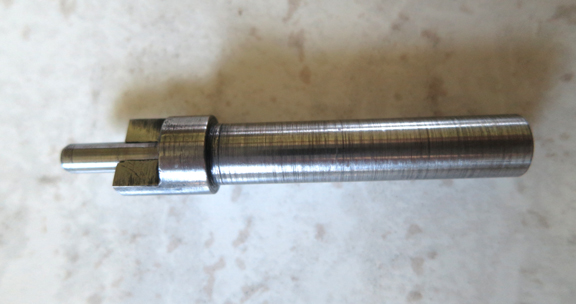* GadgetBuilder.com * © 2014 by John Moran
Last Modified:
Two Counterbores, click to enlarge
Modest size counterbores are reasonably simple to make in the home shop, it takes only a little bit of drill rod and some time. I make the pilots removable for ease of resharpening. And I use 1/8" drill rod as the pilots for simplicity - it's difficult to turn drill rod down and achieve a surface smooth enough so it remains easy to remove from the counterbore (but see lapping). So, when I use these counterbores I drill a 0.128 pilot hole, counterbore, and then drill the hole to size. Depending on your enthusiasm level, other sizes of pilots can be used.
The example counterbore shown is 0.320 diameter (shank is 0.250"), used for the heads of 10-32 socket head screws. The picture at left shows the counterbore blank turned on the end of a piece of 3/8" drill rod, ready to be parted off. After parting, the blank is reversed in the chuck and end drilled 0.120" then reamed 0.125" for the pilot; depth is about 3/8".
At right, the flats have been milled. The teeth are 0.100" thick and about 0.2" long. The pilot will be slightly proud of the teeth, making it easy to grip in a vise for removal. The hole for the pilot must be reamed again and the tool edges lightly filed to remove burrs left by milling.
The counterbore is hardened prior to sharpening; the pilot is hardened at the same time. Sharpening is simple and quick with the Brooks but can be done by hand if you don't have a similar grinder. The teeth have an 8 degree relief. If hand sharpening, it would be best to jury rig a guide of some type so the two teeth are identical. The first one I made was sharpened with a file before hardening and then lightly stoned after hardening - it worked OK but worked much better after I built the Brooks and used it to sharpen more precisely.
 The pilot is an interference fit so it is just pushed in - don't hammer it in else removal can be difficult. Friction in the tooth is light but increases as the pilot enters the shank of the tool.
The pilot is an interference fit so it is just pushed in - don't hammer it in else removal can be difficult. Friction in the tooth is light but increases as the pilot enters the shank of the tool.
Since this tool is carbon steel rather than HSS it must be used at lower RPM to avoid over heating which would soften it - it can be re-hardened and re-sharpened if this happens.
This page was last modified
. If you have a comment on this site or its contents,
click here scroll down and click again.